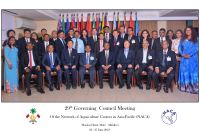The EURASTiP Exchange Programme provides opportunities for industry, researchers and educators from Europe and south-east Asia to connect and gain new perspectives while sharing innvovative ideas to help develop long term partnerships. Bursaries of up to €3,000 per exchange are available (subject to eligibility criteria) to support international innovation and collaboration. The deadline for applications is 20 September 2018. For more information on how to apply please see the EURASTiP website.
NACA’s 29th Governing Council Meeting was held in the Maldives capital, Malé, from 26-27 June, with attendance by fifteen member governments. This was the first official NACA meeting in the Maldives, since it became a member in 2014, and also the first time that most of the delegates had visited the country, affording participants a fascinating glimpse of a very different lifestyle in the archipelago, and a very different development context.
The 7th Global Symposium jointly organised by Gender in Aquaculture and Fisheries Section of the Asian Fisheries Society and Asian Institute of Technology (AIT) will be held at AIT, Bangkok during 18-20 October 2018. GAF conferences endeavour to explore the expanding horizons of gender dimensions in aquaculture and fisheries, while highlighting the need for expanding gender inclusiveness and equity. Renowned researchers from around the world will present papers on various topics related to gender issues in aquaculture and fisheries policy and practice.
The Center for Excellence for Shrimp Molecular Biology and Biotechnology (Centex Shrimp) will organise this training course from 10-21 September, 2018. Tailored to those involved in shrimp research, you will learn from the very best in the field about major and emerging shrimp diseases, shrimp farm management, gross inspection and molecular diagnosis of shrimp infectious diseases. You will have opportunities to try your hand in a series of practical sessions, including anatomical inspection using digital slides, nucleic acid detection, and many more.
Health and safety within the global aquaculture industry is widely overlooked – despite the sector posing a great risk to workers, according to University of Stirling-led research. The project found the world’s estimated 18 million aquaculture workers regularly contend with “highly hazardous” conditions and workplace injury and disease risks are high. While some aquaculture workers are highly trained and in secure jobs globally, most are from vulnerable populations in precarious work, including women, indigenous people, children, seasonal workers, migrant workers, rural and remote workers.
